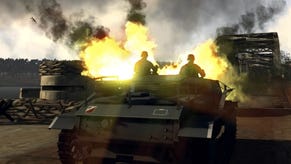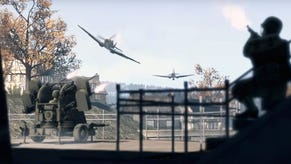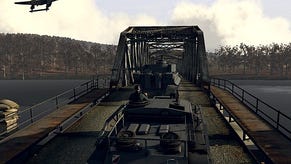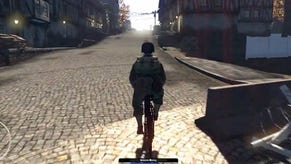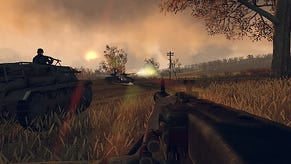Hands-on: Heroes & Generals
a bull-ring nose piercing
Heroes & Generals isn't a game. It’s two games. At least, that’s what the developers at Reto-Moto are aiming for. In one game you enter a battle as an FPS ‘hero’ while in the other you direct resources and army divisions as a strategy game ‘general’. Although it all comes in one package, the idea is that what happens in one world will ultimately affect the other. For example, moving a division of light armour to a nearby battle on the general’s map will cause tanks to appear for the players fighting on the ground. It’s not quite as simple as that, obviously, and there are a lot of requirements for things to go the way you want them when playing as a general but that’s the central idea.
As a coder would admit to me during my visit to their studio, the idea of merging different games into a single persistent world is not a new one. In fact, it’s quite fashionable at the minute. EVE Online is currently experimenting with connecting their space corporations and war fleets to Dust 514’s army boots and machine guns, even across platforms. Meanwhile Wargaming is trying to find ways for their World of Tanks to bleed into their upcoming World of Warplanes and World of Battleships. But is this drive toward over-lapping game worlds a playful arms race between MMO developers, or is it more of a quest for a holy grail of online gaming? Something ambitious but ultimately doomed?
The team at Reto-Moto are keen to emphasise that they have built this game from the ground up. Using a game engine of their own making, they focused on the FPS game first and worked their way upward, just like a grunt climbing the military ladder. So it makes sense to explain the FPS angle first. As it stands, it takes a lot of its inspiration from Battlefield, with missions currently focusing on capturing points or defending them from the assaulting enemy. But Red Orchestra was another name I heard mentioned as inspiration and this comes through in the punishing firepower of even a lone rifleman. I often killed an enemy soldier with a single shot and death came equally quickly to me. You’ll immediately understand the game as an FPS player, but you won’t immediately be very good at it.

At the same time, this beta version lacks some of the feedback of modern shooters. The flashing ‘X’ over your crosshairs when one of our bullets strikes an opponent – something we take for granted in this era of manshoots – is missing. Instead you get the old-fashioned tickertape of kills along the bottom of the screen. Likewise, keeping track of who is winning the battle is difficult and playing at night results in a lot of panicked squinting at foliage. The vehicle controls take some getting used to (and this includes the RPS favourite – the humble War Bicycle) although this doesn’t appear to have dissuaded the aeroplane ninjas that swarm these types of online battlegrounds. All this being said, any flaws are slightly forgivable when you stop to consider that it is all running impressively out of your internet browser – and it looks pretty good doing so.
It’s the strategic side of the game that garners most interest though. Every player, while off the battlefield, can view a map of the ongoing ‘war’. There can be multiple wars (with a maximum of 1000 people per side) which are basically the servers and once you join you have to see it through. Right now only the Western European front is available but the plan is to include other theatres, including North Africa and the Pacific. The idea is that what happens on this map overview will affect the battles and vice versa. At the moment this is limited to moving ‘assault teams’ around which are resources the players can use during the fight. To clarify, you aren’t actually ordering real human players about – telling a fire team to head from Caen to Paris and the like – you are instead sending resources from your capital or factories to the front. This means tanks, planes and other vehicles but perhaps most notably you are also sending extra ‘spawn credits’. For example, if the generals don’t send enough ‘troop’ resources to whatever battles are raging, their FPS players on the field will run out of respawns and be forced to concede the fight – potentially pushing back the whole frontline. We are told this raises the possibility that battles can go on for hours or even days, if the generals on both sides keep pumping resources into one fight. Although the guys in the studio say the longest battle they’ve seen lasted an hour and a half.

The players on the strategic level are also responsible for starting fights. You do this by moving your assault teams into an enemy territory and beginning a battle. These generally fall into the category of skirmish, defence or assault – all ‘control the capture points’ style game modes – but the developers are working on adding new modes which will have external consequences. Their capture the flag mode will involve stealing documents and bringing them to a friendly radio station for broadcast, at which point some of the enemy generals’ strategic movements may become visible to you. A sabotage mode will see troops sent in to blow up a bridge and, if they are successful, the route will no longer be available to the generals on the map. Another idea is to have a pilots-only battle in which one side has to dive-bomb a train track while the other defends. A successful bombing run will mean supply lines get cut off. All these missions have in mind one long-term strategic goal – to reach and capture the enemy capital. And this could take weeks or months of fighting.
I think it’s fair to say the ideas behind this strategy-action mash-up are strong. As strong at least as EVE’s plan to include orbital bombardments from spaceships on the surface planets of Dust 514. Of course, it’ll be the execution that matters. Right now the user interface for the game is – without wanting to seem impolite – a bit of a mess. Everything from the soldiers’ loadout screen to the assault team tab to the map of Europe is a confusing and cluttered collection of windows, boxes and hidden drop-down menus. If you only ever want to play as a ‘hero’ this isn’t too much of a problem – there’s a big button that just throws you straight into any fight. But if you’re looking to spend a lot of time as a general, you will need to decipher these labyrinthine menus without much help from the game itself. The fact that all the icons denoting light armour, mechanised recon and riflemen squads are the true-to-life military symbols is a very nice touch – but it would sure help to have a legend to explain which icon is which. We aren’t all military history buffs.

It’s a problem which has been recognised by the team. Everyone I spoke to admitted that they had what they called ‘an explanation problem’. Presumably the GUI is going to see a re-haul, and a tutorial for the map will be thrown in. To keep themselves amused, the programmers at Reto-Moto name each build of the game after a WWII army general. If they’re doing this alphabetically, like hurricanes, then I hope they won’t wait until the Yamamoto build to fix the ‘explanation problem’ and to add more of the promised elements to the strategic part of the game. Because as it stands this seems less like a strategy game and more like some light button-clicking that FPS players are given to do between battles.
My only other reservation is the same one I have about every free-to-play game. It’s the worry that the presence of earned ‘coins’ can turn a game about tactics or strategy into a game about economising. As it is Heroes & Generals has two currencies: credits (silver coins earned through fights) and gold (which is bought with real cash). The smallest amount of gold you can buy in one turn is 1500 which costs about €7 – fairly reasonable. The gold then converts into silver credits, which you then use to buy things. Or you can buy war bonds, which are an elaborate subscriptionesque terror that pay back interest in gold on a monthly basis and pay out a final sum, earning you a final profit in pretend money. An upcoming build will introduce a third currency called ‘war funds’ to use in the strategy game, because of the balancing issues associated with sending in loads of assault teams in tandem and farming giant sums of cash all at once. All this results in a game that would probably be more aptly named Heroes & Generals & Bankers.

Not bored of thinking about money yet? You will be. The silver earned in fighting is used A LOT. Rather than give you all classes of soldier from the beginning, thus offering the core of the game, you have only the rifleman available. Everyone else – the tank commander, the pilot, the sniper, etc – have to be unlocked. Not only that but the ‘slot’ in which to house them must also first be unlocked (for 52700 credits). Same goes for the ‘generals’ strategy game side of things. At the current pricing levels, the cheapest assault team you will be able to afford will set you back 10,560 plus the 29,000 you need for the slot to put them in. So you do have to earn your right to sit at the general’s table, which I suppose makes sense. Or you could just buy that right. It has all the standard F2P shenanigans, which are always more annoying the more in-your-face they are. And when you even have to spend your silver coins constantly maintaining the attachments on your weapons, or the amount of ammo you start a match with, then it is pretty damn in-your-face. It couldn’t be more in-your-face if it was a bull-ring nose piercing.
But then there are the usual free-to-play counter-arguments. ‘You can earn everything over a long time’, ‘you only pay a relatively small amount’, ‘it’s a free game, what do you expect?’ et cetera. I dunno. If you’re averse to intrusive F2P then I’m guessing it’s already ruined for you. If not, fire away. The main challenge now for Reto-Moto is not only to make the strategy component less opaque but also to ensure players can organise themselves in the same way other online communities have – that’s the only way an ongoing war like this is going to be any fun. Like I say, the ideas are good and the ambitious goal of making separate but smoothly interacting games within a single world is something I’ve always thought interesting, even if I’m sceptical about that particular Holy Grail being discovered.
Heroes & Generals' beta is now open to all.




